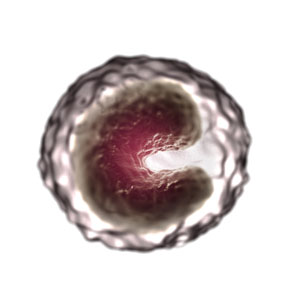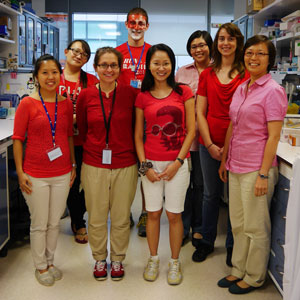
Monocytes, such as the one pictured above, are not all created equal. Understanding how regulatory protein Hsp27 affects these cells may help explain how many autoimmune diseases work.
© Science Picture Co/Collection Mix: Subjects/Getty Images
Different populations of white blood cells secrete different levels of IL-1β, a pro-inflammatory protein that normally helps the body fight off infection and injury, but may also trigger autoimmune disease and inflammatory diseases. An investigation by A*STAR researchers and collaborators shows that a regulatory protein called Hsp27 is responsible for some of these differences in subsets of monocytes.
The results help explain some of the diversity and sub-specialization of the immune system — and could yield new treatment strategies for patients with rheumatoid arthritis, colitis, diabetes and other ailments.
“These findings represent the first comprehensive and unifying data on IL-1β production by monocytes, and identify the Hsp27 pathway as a main player and potential novel therapeutic target for inflammatory disease,” says Wong Siew Cheng from the A*STAR Singapore Immunology Network, who led the research project.
Wong teamed up with Heather Wilson, an immunologist at the University of Sheffield in the United Kingdom, to study IL-1β production in different subsets of monocytes. The two researchers jointly supervised a PhD student, Éva Hadadi, who used surface markers to sort monocytes isolated from human blood into three subpopulations: classical, intermediate and non-classical monocytes.
Hadadi then induced IL-1β production and maturation through a two-step stimulation protocol. In this way, the researchers observed that classical and intermediate monocytes produced and released more than twice as much IL-1β as non-classical monocytes.
They then searched exhaustively and systematically for reasons to explain this differential production of IL-1β. Non-classical monocytes were no less receptive to the stimulation protocol, they found, so that didn’t account for their low IL-1β output. Nor were these white blood cells generally deficient in their ability to produce pro-inflammatory signaling proteins or process their maturation.

Wong Siew Cheng (far right) and her lab group, including former PhD student Éva Hadadi (third from the left).
© 2017 A*STAR Singapore Immunology Network
“Instead,” says Wong, “these cells expressed abundant Hsp27,” an essential subunit of a protein complex involved in breaking down the RNA transcripts of IL-1β before they can be turned into proteins. As a result of this differential Hsp27 activity, overall IL-1β levels remained low in non-classical monocytes but high in classical monocytes.
The findings indicate that IL-1β-spewing classical monocytes are the true culprits behind inflammatory disease and that therapies designed to boost Hsp27 levels in these cells might help tamp down unwanted inflammation. However, Wong notes that Hsp27 is also known to promote other pro-inflammatory molecules. “Hence,” she says, “the type of treatment option to utilize will be based on the type of disease.”
The A*STAR-affiliated researchers contributing to this research are from the Singapore Immunology Network. For more information about the team’s research, please visit Wong Siew Cheng’s webpage.



